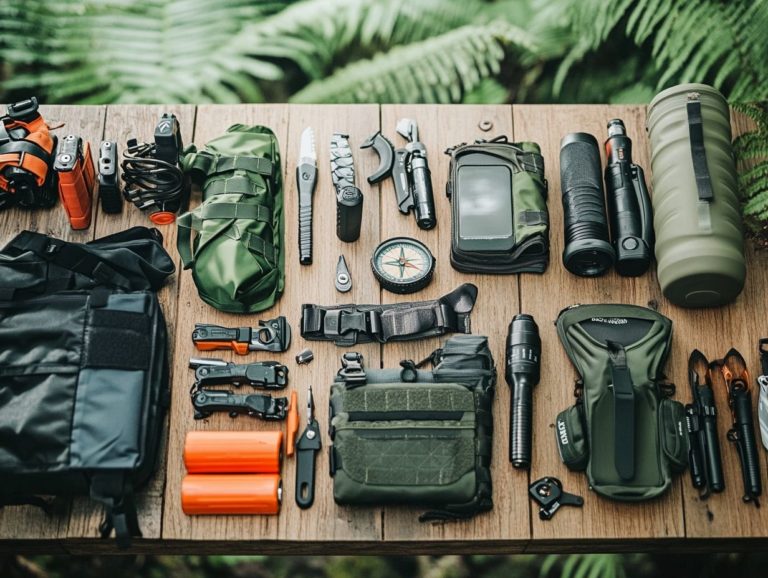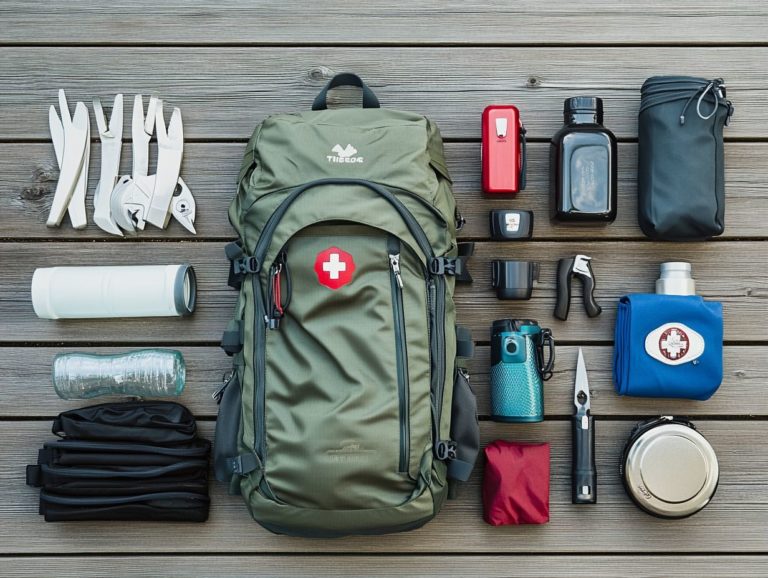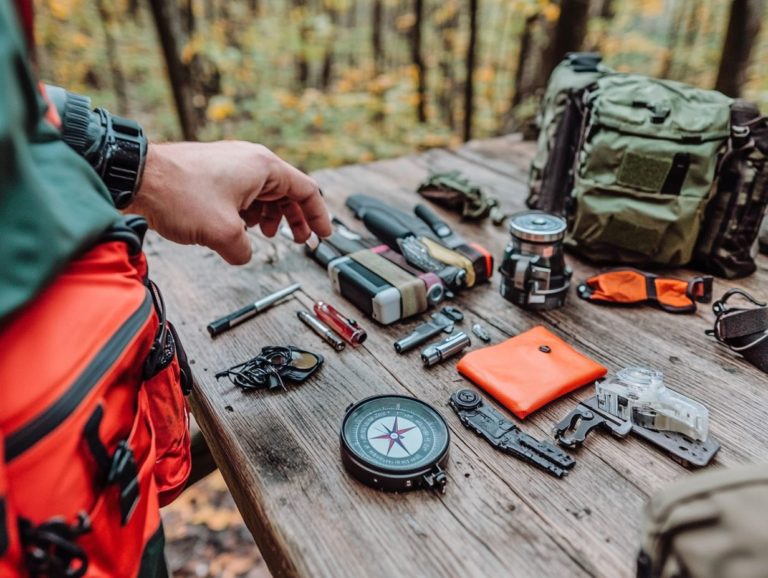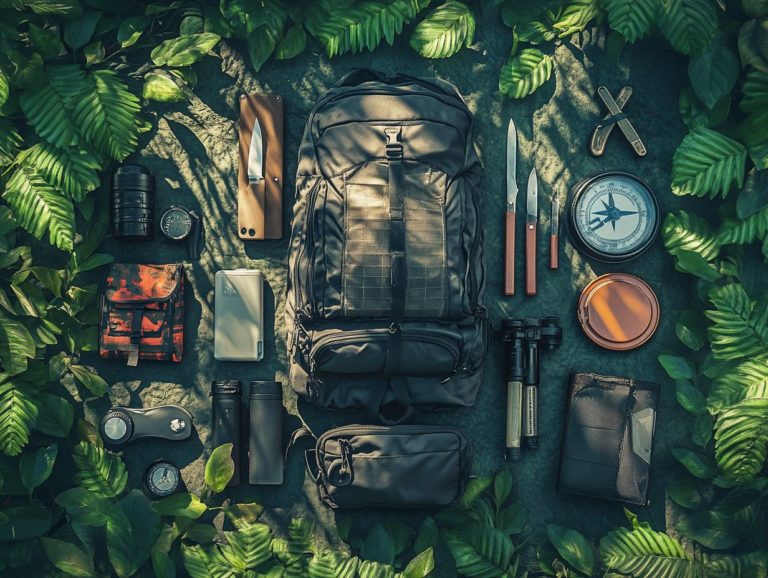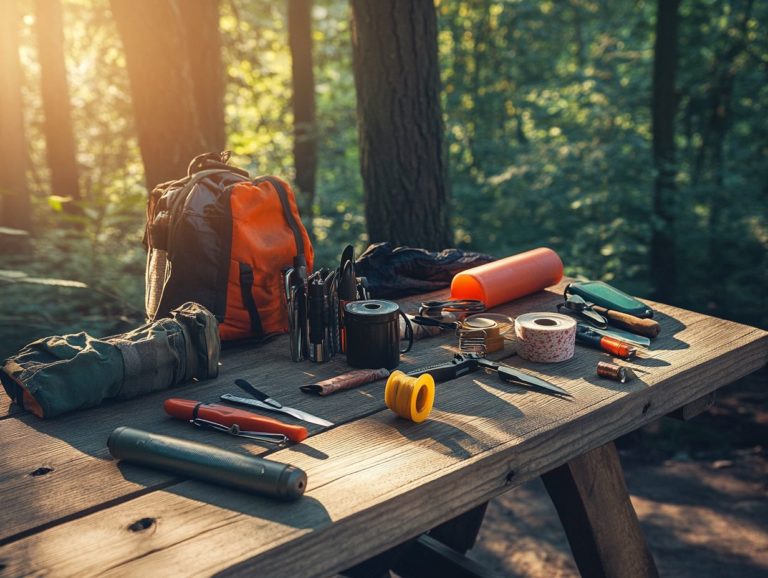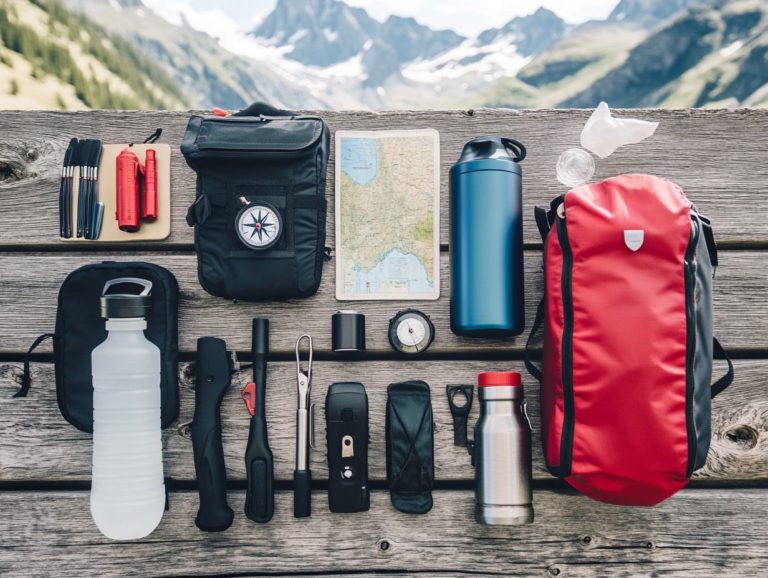Top 5 Survival Gear Kits for Beginners
In today s unpredictable world, being prepared for emergencies has never been more crucial. Whether you re venturing into the wilderness or simply aiming to ensure your family’s safety at home, possessing the right survival gear can truly make a significant difference.
This article delves into the essential items you should include in your survival kit, ranging from basic first aid supplies to navigation tools and portable stoves. It also guides you on assessing the quality of your gear, customizing your kit to fit your unique needs, and avoiding common mistakes that beginners often make.
Dive in to discover how you can equip yourself for any situation!
Contents
- Key Takeaways:
- 1. Basic First Aid Kit
- 2. Water Filtration System
- 3. Emergency Shelter
- 4. Multi-Tool
- 5. Fire Starter Kit
- 6. Navigation Tools
- 7. Food Rations
- 8. Personal Protection Items
- 9. Communication Devices
- 10. Lighting Equipment
- 11. Emergency Blanket
- 12. Portable Stove
- 13. Hygiene and Sanitation Items
- 14. Emergency Whistle
- 15. Survival Guide Book
- What Are the Essential Items in a Survival Gear Kit?
- Frequently Asked Questions
- What are the top 5 survival gear kits for beginners?
- Why is it important for beginners to have survival gear kits?
- What items should be included in a basic first aid kit for survival?
- How does a fire starting kit help in survival situations?
- Why is a multi-tool important in a survival gear kit?
- How does an emergency shelter kit assist in survival situations?
Key Takeaways:
- A basic first aid kit is a must-have for beginners, as injuries can happen anytime in the wilderness.
- Water is essential for survival, so a water filtration system should be included to ensure safe drinking water.
- Emergency shelters, such as tents or tarps, are crucial for protection against harsh weather conditions and should be included in a survival kit.
1. Basic First Aid Kit
A Basic First Aid Kit is an essential part of your survival toolkit, offering you the medical supplies needed to tackle injuries and health emergencies while adventuring in the great outdoors. This kit helps you treat injuries quickly. It also boosts your overall preparedness for unexpected situations.
Make sure to include various sizes of bandages for those inevitable cuts and scrapes, antiseptics to ward off infections, and pain relievers to help manage any discomfort you might encounter. These items are vital in prioritizing your survival, ensuring that injuries can be addressed swiftly and effectively.
Depending on your environment, consider customizing your first aid kit with specific items, like burn creams for desert excursions or splints for navigating rugged terrains.
By being aware of the potential risks associated with your activities, you can equip yourself more effectively for emergencies, ultimately creating a safer and more enjoyable outdoor experience.
2. Water Filtration System
A reliable water filtration system is essential for your survival kit, enabling you to secure safe drinking water efficiently. This critical component not only helps you avoid dehydration but also protects you against diseases from dirty water, making it an essential part of any wilderness survival strategy.
Consider the various types of water filtration systems available, like the compact Katadyn Micropur, each offering tailored solutions for different outdoor scenarios. For example, portable filters can be lifesavers during your backpacking adventures, while gravity-fed systems are ideal for group camping trips where multiple users require clean water.
Understanding the specific needs of each situation is vital for instance, filtering lake water versus running streams. This knowledge ensures your water safety. Properly utilizing these systems means knowing how to set them up and maintain them, as well as recognizing when it s essential to purify water, especially in remote areas where clean sources are hard to come by.
3. Emergency Shelter
Emergency shelters are essential components of your survival kit, offering you protection from the elements and ensuring safety in unpredictable weather. A portable shelter, such as the Tact Bivvy, can greatly enhance your chances of survival by providing warmth, security, and a place to rest during emergencies.
Among the many options available, tents are particularly noteworthy for their spaciousness and stability, making them ideal for longer stays in one spot. They come in a variety of shapes and sizes, featuring waterproof materials and user-friendly setup mechanisms.
Bivvy bags are lightweight and compact, perfect for those who prioritize mobility yet still require protection from wind and rain. Plastic sheeting is also a versatile option for creating makeshift shelters, allowing you to adapt it to various environments as needed.
When selecting the right emergency shelter, consider factors such as expected weather conditions, terrain, and your personal needs to ensure optimal safety and comfort.
What s in your survival kit? Share your tips with us in the comments!
4. Multi-Tool
A multi-tool is an essential piece of everyday carry gear for your survival kit. It provides a range of functionalities in one compact design. Whether you need to cut, screw, or open a can, a quality multi-tool simplifies your tasks significantly. Choose your multi-tool wisely to tackle any challenge you might face outdoors!
These versatile instruments come equipped with features like pliers, wire cutters, multiple knife blades, and an array of screwdrivers, all tailored to meet diverse needs.
When selecting a reliable multi-tool, reflect on the specific outdoor activities you frequently enjoy, such as camping, hiking, or fishing. Your preferences regarding size, weight, and tool accessibility can greatly influence your selection.
Make sure the multi-tool feels comfortable and intuitive in your hand. This will enhance your overall experience during any outdoor excursion, allowing you to tackle unexpected challenges with ease and confidence.
5. Fire Starter Kit
A fire starter kit is essential for your survival gear collection. It allows you to master the art of fire-making, even in the most challenging conditions. Key components, including a ferro rod and a reliable fire starter, ensure you can ignite a flame swiftly. This provides warmth, enables cooking, and signals potential rescuers in emergencies.
To assemble an effective kit, incorporate various types of tinder, such as:
- dry leaves
- cotton balls dipped in petroleum jelly
- specially designed fire starter cubes
Waterproof matches or a dependable lighter are crucial to guarantee you can access a flame, even in damp environments.
When exploring different fire-starting techniques, consider methods like the teepee or log cabin formations. These enhance airflow and efficiency. It’s vital to stay vigilant, adhering to safety precautions by clearing your fire site of flammable debris and being mindful of wind direction to prevent an uncontrollable spread.
Always remain aware of local regulations and fire bans. This ensures that you protect both yourself and the environment while enjoying your outdoor adventures. Don t wait until it s too late; gather your fire starter kit today!
Navigation tools are vital components of your survival kit. They equip you with the means to orient yourself and traverse unfamiliar terrain safely. By utilizing items like compasses, maps, and even signal mirrors, you can significantly enhance your ability to navigate through wilderness environments, ensuring a safer and more fulfilling outdoor experience.
Among the various navigation tools at your disposal, traditional compasses offer a straightforward yet reliable method for finding direction. They work by harnessing the Earth’s magnetic field, guiding you toward magnetic north when aligned correctly.
Modern GPS devices utilize satellite signals to pinpoint your precise location. This enables detailed route planning and real-time tracking. While both tools serve the essential purpose of navigation, it’s best to incorporate compasses alongside maps for improved accuracy.
Relying solely on GPS in remote areas can be risky due to potential signal loss. Thus, becoming familiar with the operation of each tool is essential for any outdoor adventurer aiming for success in the wild.
7. Food Rations
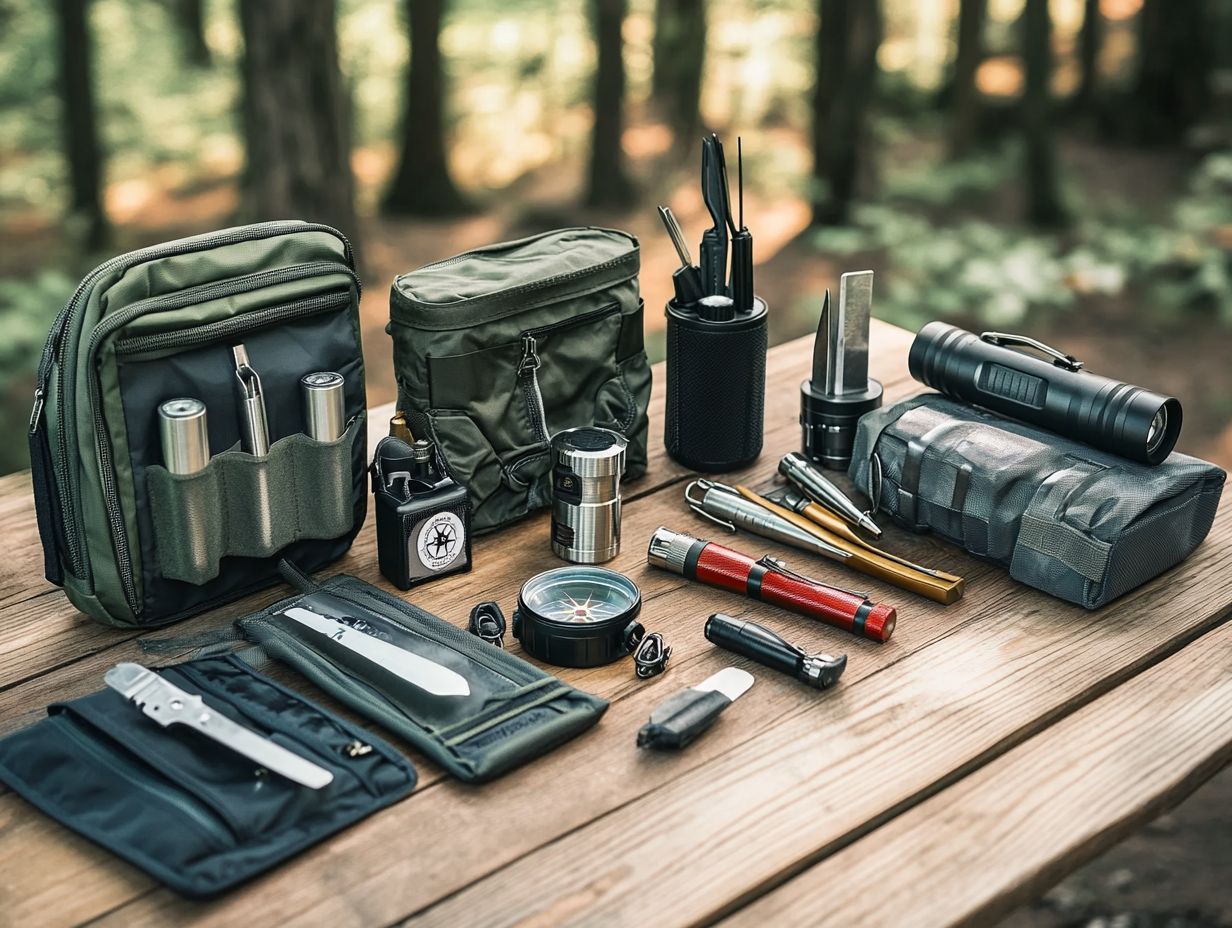
Food rations are an essential part of your survival kit. They ensure you have access to important food during emergencies. Opting for budget-friendly survival food options allows you to secure the necessary calories and nutrients to maintain your energy levels. This makes them a key part of surviving in the wild.
Among the various types of survival food available, freeze-dried meals truly shine with their ease of preparation and impressive shelf life. They come in a delightful array of flavors, offering balanced nutrition while remaining lightweight perfect for your outdoor adventures.
Energy bars are another smart choice. They are compact and loaded with calories, providing quick energy boosts when you need them most.
When selecting food rations, consider not just the weight and nutritional content, but also the ingredient list to steer clear of allergens. Prioritize meals that are high in protein and fiber; these elements will keep you satisfied longer, ensuring your rations can withstand the demands of outdoor life.
8. Personal Protection Items
Personal protection items are crucial in your survival kits. They offer you peace of mind as you navigate various terrains and situations.
Including high-quality survival knives, such as ESEE Knives, can significantly enhance your safety. They give you the ability to defend yourself against wildlife or tackle multiple survival tasks with confidence.
Along with knives, bear spray is an essential deterrent in areas where large animals might occur. It provides an extra layer of security without resorting to lethal measures.
Protective gear like sturdy boots and durable clothing is equally vital. It safeguards your body from injury while you hike or camp.
When selecting the right items, consider factors such as your specific environment, potential wildlife threats, and the type of outdoor activities you ll be engaging in. This careful consideration ensures that each item meets safety standards and aligns with your personal comfort and ease of use.
9. Communication Devices
Communication devices are essential elements of your survival kit. They allow you to stay connected with the outside world and signal for assistance when necessary.
Whether you opt for a satellite phone, a two-way radio, or even a simple whistle, having a reliable means of communication can be crucial for your safety and successful rescue during emergencies.
These tools give you peace of mind and elevate your outdoor experience. They enable you to navigate unfamiliar terrains, share your location, and communicate vital information with fellow adventurers.
Satellite phones are invaluable in remote areas where traditional cell service is nonexistent. It’s crucial to know how each device works, such as how far a two-way radio can communicate or the importance of keeping your satellite phone charged.
Practicing proper protocols for emergency communication ensures a swift response when needed. This allows you to explore with enhanced confidence!
10. Lighting Equipment
Lighting equipment is an essential component of your survival kit. It allows you to navigate and accomplish tasks safely after the sun sets.
Whether you opt for headlamps, flashlights, or glow sticks, having dependable lighting significantly boosts your visibility and enhances your safety. Having the right lighting can be the difference between safety and danger in the dark!
Different types of lighting equipment come with unique features tailored to various outdoor conditions. For example, headlamps provide hands-free illumination, making them ideal for tasks that require both light and dexterity.
Compact flashlights are perfect for portability, easily slipping into your pocket or pack. Glow sticks, while not rechargeable, can serve as reliable signals in emergencies.
When choosing the best lighting options, consider battery life for longevity during extended trips, durability to withstand the elements, and weight to avoid unnecessary strain on your gear. Understanding these aspects will greatly enhance your outdoor experiences while keeping safety and preparedness at the forefront.
11. Emergency Blanket
An emergency blanket can be a lifesaver! It is an essential addition to your survival kit, offering you lightweight and compact protection against hypothermia in critical situations.
This versatile piece of gear keeps you warm and serves as a signaling device and ground cover, showcasing its usefulness in many situations.
Crafted from materials like Mylar, a special type of plastic that reflects heat, these blankets reflect up to 90% of your body heat. They are incredibly effective for maintaining warmth in cold environments.
The shiny surface can catch light, helping you attract attention when every second counts. To maximize its utility in your survival kit, fold the blanket neatly to save space.
Don t overlook the importance of practicing quick deployment. Pairing the blanket with other essential items, such as a first aid kit and water purification tools, will create a comprehensive emergency preparedness strategy that keeps you ready for whatever challenges may arise.
Don t wait equip your survival kit today!
12. Portable Stove
A portable stove is an essential addition to your survival kit. It enables you to cook meals and purify water efficiently while immersed in the great outdoors. Having a reliable cooking method is not just a luxury; it s vital for conserving energy and ensuring food safety. For anyone serious about wilderness survival, this is a must-have!
There are different types of compact stoves, including propane burners, alcohol stoves, and wood-burning options. Each is designed to cater to your specific needs and preferences. When choosing your stove, weight is a crucial factor, especially if you re a hiker or backpacker who values portability without compromising functionality.
Some lightweight models pack down to nearly nothing, making them ideal for long treks. On the other hand, sturdier, heavier options might better suit car campers who prioritize durability and cooking versatility.
Ultimately, the stove you choose can dramatically enhance your outdoor cooking experience, offering a range of benefits from quick meal preparation to efficient fuel use.
13. Hygiene and Sanitation Items
Hygiene and sanitation items are often overlooked, yet they are an essential part of your survival kit. Items like biodegradable soap and hand sanitizers will enhance your comfort while outdoors. Including personal hygiene products can significantly improve your safety in wilderness environments.
Incorporating toothbrushes, dental floss, and menstrual hygiene supplies is crucial. Maintaining oral health and attending to bodily functions can profoundly impact your overall morale. Prioritize easy-to-carry items that serve more than one purpose to conserve space.
Effective management of these supplies begins with organizing them in clearly marked pouches or containers. This ensures they are readily accessible while you re on the move.
Regularly checking expiration dates and replenishing supplies after each trip is essential. This practice guarantees that you are always prepared, ultimately leading to a more enjoyable and healthier outdoor experience.
14. Emergency Whistle
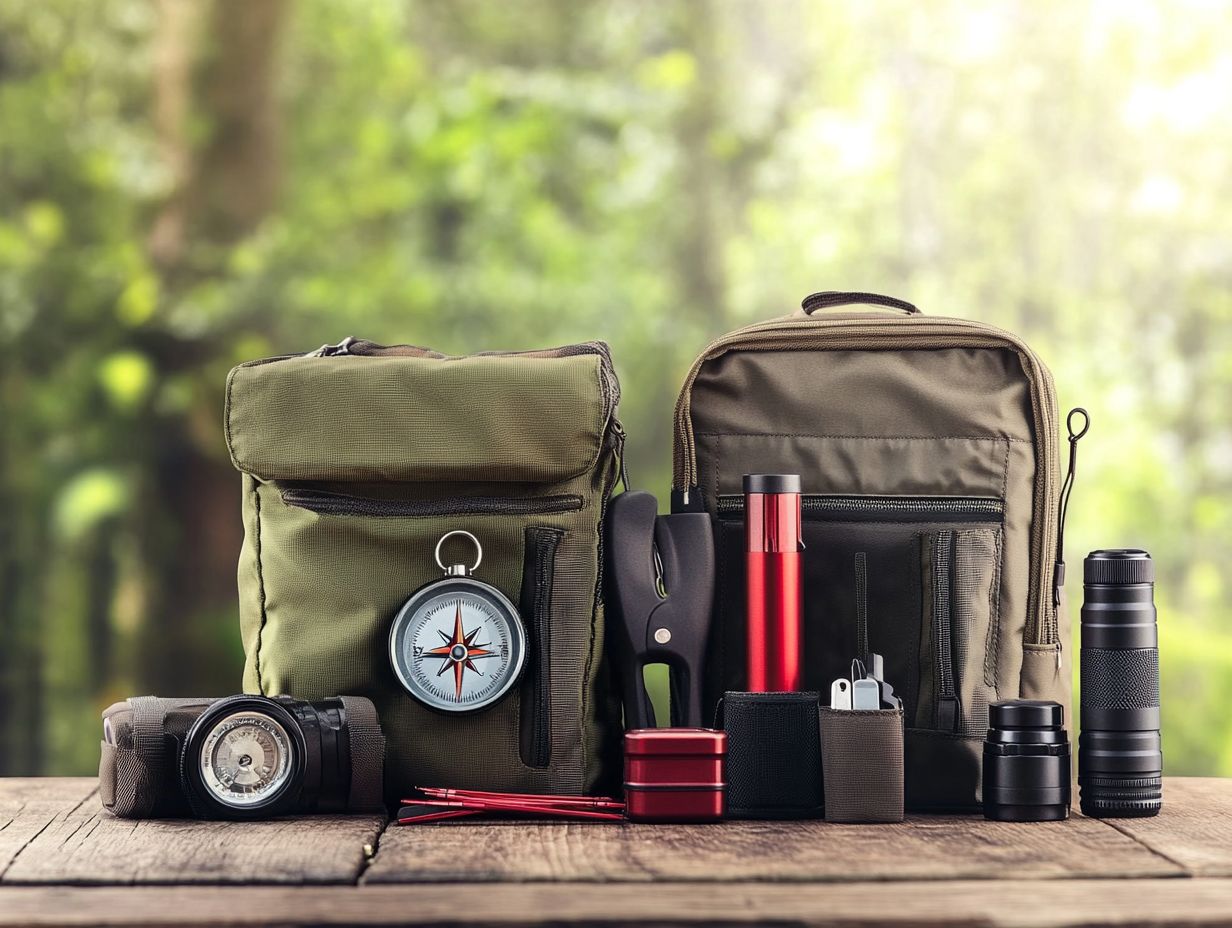
An emergency whistle is a compact yet powerful addition to your survival kit. It acts as an effective signaling tool for outdoor enthusiasts like yourself in times of distress. The loud sound it produces can travel impressive distances, making it an essential item to attract attention and boost your chances of rescue during emergencies.
Unlike shouting, which can strain your vocal cords and struggle to carry in windy or dense environments, a whistle offers a consistent and reliable signal that slices through background noise. When using the whistle, aim for short bursts to create recognizable patterns that stand out.
In wooded areas, keep the whistle attached to a lanyard or tucked securely in your pocket. Regular maintenance like checking for debris inside and ensuring the sound isn’t obstructed keeps it ready for critical situations. When paired with other signaling methods, the whistle significantly enhances your safety while you explore the great outdoors.
15. Survival Guide Book
A survival guidebook is an invaluable resource for you as an outdoor enthusiast. It equips you with essential knowledge and strategies for effectively navigating the wilderness. This guide covers essential survival techniques, from navigation to fire making, making it a must-have addition to your survival kit if you’re serious about safety and preparedness.
A comprehensive guide should explore the identification of local flora and fauna, referring to plants and animals in the area you ll be exploring. This knowledge enables you to make informed decisions about foraging while steering clear of dangerous plants or animals. It should also outline emergency procedures, detailing how to handle unexpected situations whether it’s an injury or a sudden change in weather.
When selecting a quality survival guide, consider the specific outdoor activities you engage in, be it hiking, camping, or backpacking. Ensuring that the material is tailored to your experiences will maximize your preparedness. You might also want to check out the top accessories for outdoor survival kits to grant you peace of mind in the great outdoors. Make this guide your trusted companion in every adventure!
What Are the Essential Items in a Survival Gear Kit?
Essential items in your survival gear kit include tools and supplies crucial for navigating emergencies. By prioritizing components like first aid supplies, emergency shelters, and communication devices, you equip yourself to handle the unexpected while enjoying your adventures in nature.
Each of these elements fulfills its specific purpose and contributes significantly to important aspects of survival. For instance, first aid supplies enable you to respond swiftly to injuries, minimizing the risk of complications. Emergency shelters offer vital protection from the elements, ensuring your safety if stranded. Communication devices serve as your lifeline to the outside world, which can be invaluable in critical situations.
When putting together your survival kit, it’s key to assess your personal needs based on factors such as location, climate, and the duration of your outdoor activities. This tailored approach prepares you to confidently face any challenges in the wild!
How Can One Determine the Quality of Survival Gear Kits?
Determining the quality of survival gear kits is essential for outdoor enthusiasts like you, who seek dependable and effective equipment for your adventures. Key factors to consider include the materials used, the reputation of brands, and whether the kit aligns with your specific survival priorities.
Durability is crucial; your gear should withstand harsh weather conditions and rugged handling. Functionality matters just as much, so focus on multi-use tools that can serve several purposes.
User reviews provide valuable insights into real-world performance. They help you evaluate the effectiveness of different kits. If you’re on a budget, don t worry plenty of fantastic options won’t break the bank!
Brands like Adventure Medical Kits and the ready-to-go options from Survivor Filter strike an excellent balance between affordability and reliability, making them worthy considerations for anyone like you venturing into the great outdoors. Additionally, knowing what to include in your survival gear kit can further enhance your outdoor experience.
What Are the Different Types of Survival Gear Kits Available?
Survival gear kits come in a variety of types, each tailored to meet the unique needs of outdoor enthusiasts. Whether you re looking for a basic kit for a leisurely outing or a specialized option for more extreme environments, understanding these different types will help you select the best survival kit for your specific activities and conditions.
A basic kit typically includes essential items like a flashlight, multi-tool, and first aid supplies ideal for day hikes or short camping trips. For women looking for specialized options, consider checking out the top 5 survival gear for women.
On the other hand, adventure kits are designed for those venturing into remote areas and may include gear such as water purification tablets, fire-starting tools, and navigation aids. If you’re a city dweller, urban survival kits focus on items that are more suited to your environment, featuring self-defense tools, emergency food rations, and vital information resources. For those preparing for outdoor excursions, consider the top 7 survival gear items for the wilderness to ensure you’re well-equipped.
When choosing the right kit, it s essential to assess your personal needs, consider regional risks, and outline the specific activities you have planned. This thoughtful approach ensures that you re prepared for any scenario that might arise.
How Can One Customize Their Own Survival Gear Kit?
Customizing your survival gear kit allows you to tailor your equipment to specific activities and environments, maximizing your preparedness and efficiency. By carefully selecting each component based on your individual needs, you can create a kit that aligns with your unique survival priorities and lifestyle.
This process begins with a thorough assessment of your personal requirements. Consider factors such as your geographic location, anticipated weather conditions, and planned activities.
Once you’ve identified these needs, the next step is to choose components that not only serve their intended purpose but also complement one another in terms of functionality. Versatility is key; lightweight multipurpose tools, for example, can save space and enhance usability.
Don t overlook the critical step of testing your custom kit in real-world scenarios. Ensuring that each component operates effectively under varying conditions will lead to greater confidence and readiness when emergencies strike.
What Are the Most Common Mistakes Beginners Make When Choosing a Survival Gear Kit?
Beginners frequently encounter common missteps when selecting a survival gear kit, which can put their safety at risk during outdoor excursions. By understanding these pitfalls such as overpacking, overlooking personal needs, and failing to research reputable brands you can act now to refine your selection process and ensure your safety in the wilderness.
Many newcomers tend to stuff their kits with unnecessary items, resulting in excess weight that can impede mobility. Focus on the essentials tailored to your specific activities, whether hiking, camping, or backpacking. To ensure you’re well-prepared, check out the top features to look for in survival gear that suit your unique environment, weather conditions, and personal health requirements when curating your gear.
Educating yourself about reputable manufacturers can save you from investing in subpar equipment that may fail in critical situations. Choose durable and functional gear instead of just good-looking options to craft a more reliable survival kit customized to your needs.
Frequently Asked Questions
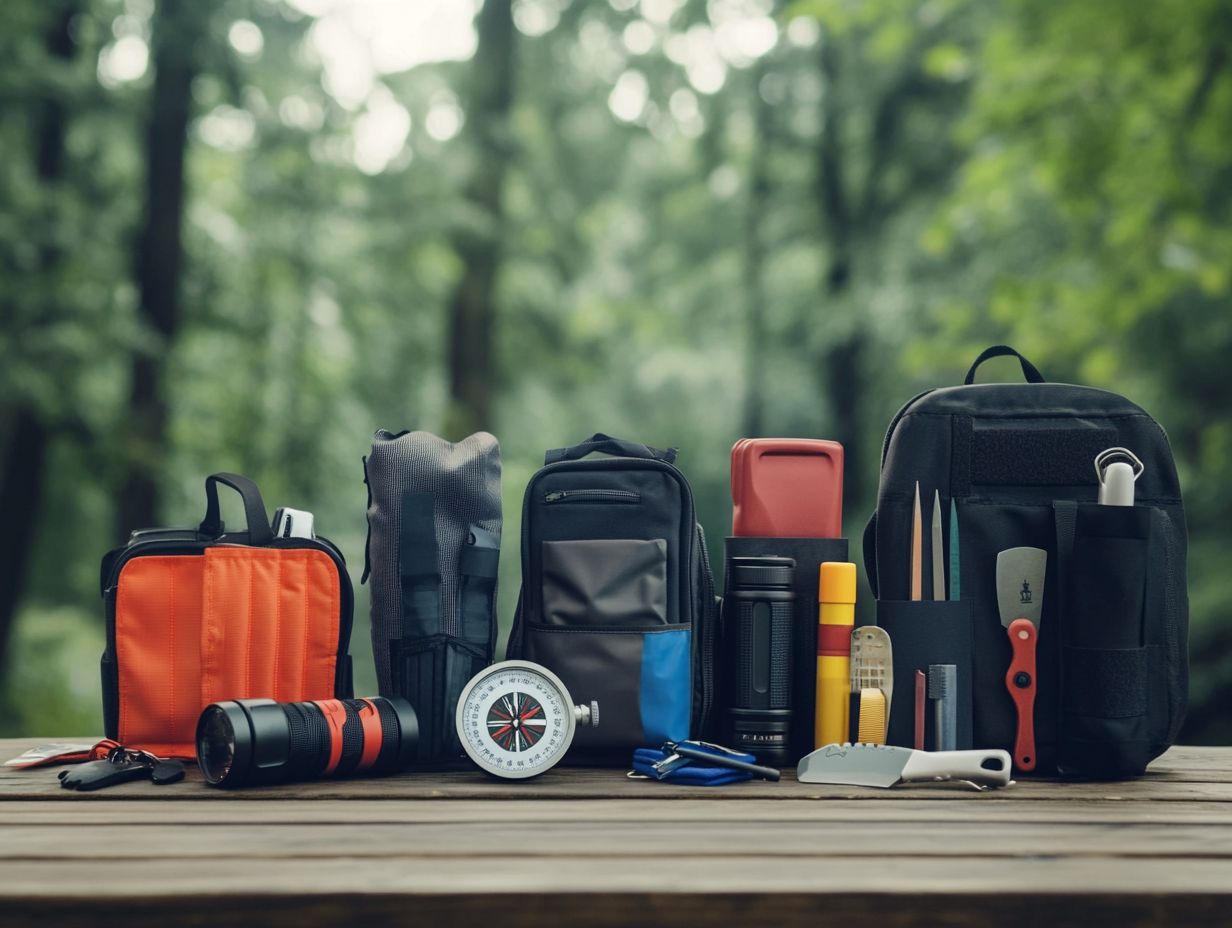
-
What are the top 5 survival gear kits for beginners?
The top 5 survival gear kits for beginners are the Basic First Aid Kit, Fire Starting Kit, Multi-Tool, Emergency Shelter Kit, and Water Filtration System.
-
Why is it important for beginners to have survival gear kits?
Having survival gear kits is important for beginners because it aids in their safety and survival in emergency situations. It also provides them with the necessary tools and resources to handle unexpected challenges.
-
What items should be included in a basic first aid kit for survival?
- Bandages
- Gauze pads
- Antiseptic wipes
- Adhesive tape
- Pain relievers
- Tweezers
- Emergency blanket
- Personal medications
-
How does a fire starting kit help in survival situations?
A fire starting kit is essential for survival, providing means to cook food, purify water, and stay warm. It typically includes matches, a lighter, fire starter cubes, and tinder to easily start a fire.
-
Why is a multi-tool important in a survival gear kit?
A multi-tool is crucial in a survival gear kit because it combines various tools in one compact device. It can be used for tasks such as cutting, sawing, opening cans, and even as a self-defense tool.
-
How does an emergency shelter kit assist in survival situations?
An emergency shelter kit provides protection from the elements and is crucial in extreme weather. It typically includes a lightweight tent, tarp, or emergency blanket, along with rope and stakes for setting up shelter.

